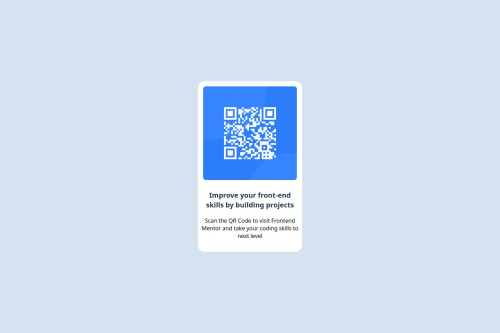Componente de QR Code feito usando HTML e CSS

Solution retrospective
Por mais simples que seja, foi a primeira coisa que eu fiz com meus proprios recursos, sem um tutorial passo a passo
What challenges did you encounter, and how did you overcome them?centralizar o componente sem usar flexbox
Please log in to post a comment
Log in with GitHubCommunity feedback
- @benssssss
Olá, vi seu código e vou sugerir algumas alterações.
Você poderia colocar seus textos (h1 e p) dentro de uma div, assim como fez com a imagem, e então aplicar um padding diretamente nessa div, em vez de colocá-lo nos textos individualmente. Isso tornaria seu CSS mais limpo.
Notei que você usou translate para centralizar o cartão, o que funciona, mas não é a melhor abordagem, na minha opinião. Como você está aprendendo, pode não ter tido contato com display: flex;, que facilita muito o posicionamento dos elementos com menos código.
O que eu faria é:
1 - Remover a centralização do .card
.card { /* position: absolute; */ /* remover */ /* top: 50%; */ /* remover */ /* left: 50%; */ /* remover */ /* transform: translate(-50%, -50%); */ /* remover */ /* margin: auto; */ /* remover */ width: 300px; border-radius: 20px; background-color: var(--white); }2 - Definir e centralizar o .card usando flex
body { /* max-width: 1444px; */ /* remover */ font-family: Outfit, Arial, Helvetica, sans-serif; background-color: var(--slate-300); display: flex; justify-content: center; align-items: center; height: 100vh; }display: flex; define o body como um contêiner flexível.
justify-content: center; centraliza o .card horizontalmente.
align-items: center; centraliza o .card verticalmente.
Porém, por padrão, o body tem a altura do conteúdo (neste caso, o .card, que tem 466px). Se aplicarmos align-items: center;, nada mudará, pois o conteúdo já está no centro do body. Para resolver isso, adicionamos height: 100vh;, que define a altura do body como 100% da tela do dispositivo, garantindo que o .card fique exatamente no meio da página.
Seu HTML é semântico e seu CSS está bem organizado.
Parabéns pelo primeiro projeto!
Join our Discord community
Join thousands of Frontend Mentor community members taking the challenges, sharing resources, helping each other, and chatting about all things front-end!
Join our Discord